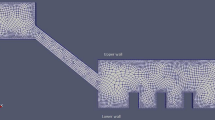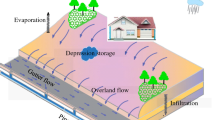Abstract
Analytical simulation of groundwater flow is a necessary and useful technique to predict the various behavior patterns of a groundwater system. The main aim of the present study is to derive new analytical solutions to compute the unsteady flows inside an aquifer between two parallel streams of constant and varying heads. The problems are solved by means of Laplace transform method and the solution results are verified with the results of MODFLOW. It is observed that the obtained results agreed very well with the results of MODFLOW. The solutions are carried out for two cases of ascending and descending water levels and the obtained results are compared with each other. In addition, the sensitivity of hydraulic heads to aquifer parameters and how locations of water divide change by change in aquifer parameters are investigated. In sensitivity analysis of hydraulic heads to changes in recharge rate with different values of hydraulic conductivity, thickness, and length of the aquifer, it is shown that among these parameters the length of the aquifer is the most important parameter affecting the hydraulic heads. Furthermore, the sensitivity of flow rates to recharge rates and water level change rates are analyzed.










Similar content being viewed by others
References
Bansal RK, Das SK (2009) Analytical solution for transient hydraulic head, flow rate and volumetric exchange in an aquifer under recharge condition. J Hydrol Hydromech 57(2):113–120. doi:10.2478/v10098-009-0010-4
Bansal RK, Das SK (2010) Water table fluctuations in a sloping aquifer: analytical expressions for water exchange between stream and groundwater with surface infiltration. J Porous Media 13(4):365–374. doi:10.1615/JPorMedia.v13.i4.70
Bansal RK, Das SK (2011) Response of an unconfined sloping aquifer to constant recharge and seepage from the stream of varying water level. Water Resour Manag 25(3):893–911. doi:10.1007/s11269-010-9732-7
Barlow PM, Desimone LA, Moench AF (2000) Aquifer response to stream-stage and recharge variations.II. Convolution method and applications. J Hydrol 230:211–229. doi:10.1016/S0022-1694(00)00176-1
Boufadel MC, Peridier V (2002) Exact analytical expressions for the piezometric profile and water exchange between stream and groundwater during and after a uniform rise of the stream level. Water Resour Res 38(7):27.1–27.6. doi:10.1029/2001WR000780
Chen JW, Hsieh HH, Yeh HF, Lee CH (2010) The effect of the variation of river water levels on the estimation of groundwater recharge in the Hsinhuwei River, Taiwan. Environ Earth Sci 59:1297. doi:10.1007/s12665-009-0117-2
Darama Y (2001) An analytical solution for stream depletion by cyclic pumping of wells near streams with semipervious beds. Groundwater 39(1):79–86. doi:10.1111/j.1745-6584.2001.tb00353.x
Di Matteo L, Dragoni W (2005) Empirical relationships for estimating stream depletion by a well pumping near a gaining stream. Groundwater 43(2):242–249. doi:10.1111/j.1745-6584.2005.0006.x
Dong L, Chen J, Fu C, Jiang H (2012) Analysis of groundwater-level fluctuation in a coastal confined aquifer induced by sea-level variation. Hydrogeol J 20(4):719–726. doi:10.1007/s10040-012-0838-2
Emikh VN (2008) Mathematical models of groundwater flow with a horizontal drain. Water Res 35(2):205–211. doi:10.1134/S0097807808020097
Fen C-S, Yeh HD (2012) Effect of well radius on drawdown solutions obtained with Laplace transform and Green’s function. Water Resour Manag 26:377–390. doi:10.1007/s11269-011-9922-y
Feng Q, Wen Z (2016) Non-Darcian flow to a partially penetrating well in a confined aquifer with a finite-thickness skin. Hydrogeol J 24(5):1287–1296. doi:10.1007/s10040-016-1389-8
Hall FR, Moench AF (1972) Application of the convolution equation to stream-aquifer relationships. Water Resour Res 8:487–493. doi:10.1029/WR008i002p00487
Hantush MM (2005) Modeling stream–aquifer interactions with linear response functions. J Hydrol 311(1):59–79. doi:10.1016/j.jhydrol.2005.01.007
Haushild W, Kruse G (1962) Unsteady flow of groundwater into a surface reservoir. Trans Am Soc Civ Eng 127:408–414
Huang CS, Lin WS, Yeh HD (2014b) Stream filtration induced by pumping in a confined, unconfined or leaky aquifer bounded by two parallel streams or by a stream and an impervious stratum. J Hydrol 513(26):28–44. doi:10.1016/j.jhydrol.2014.03.039
Huang CS, Yang SY, Yeh HD (2014a) Groundwater flow to a pumping well in a sloping fault zone unconfined aquifer. Water Resour Res 50(5):4079–4094. doi:10.1002/2013WR014212
Jasrotia AS, Kumar A (2014) Estimation of replenishable groundwater resources and their status of utilization in Jammu Himalaya, J&K, India. Eur Water 48:17–27
Kalaidzidou-Paikou N, Karamouzis D, Moraitis D (1997) A finite element model for the unsteady groundwater flow over sloping beds. Water Resour Manag 11(1):69–81. doi:10.1023/A:1007926507718
Kim KY, Kim Y, Lee CW, Woo NC (2003) Analysis of groundwater response to tidal effect in a finite leaky confined coastal aquifer considering hydraulic head at source bed. Geosci J 7(2):169–178. doi:10.1007/BF02910221
Krajnc M, Gacin M, Krsnik P, Sodja E, Kolenc A (2007) Groundwater quality in Slovenia assessed upon the results of national groundwater monitoring. Eur Water 19(20):37–46
Li H, Jiao JJ (2002) Analytical solutions of tidal groundwater flow in coastal two-aquifer system. Adv Water Resour 25(4):417–426. doi:10.1016/S0309-1708(02)00004-0
Rai S, Manglik A (2012) An analytical solution of Boussinesq equation to predict water table fluctuations due to time varying recharge and withdrawal from multiple basins, wells and leakage sites. Water Resour Manag 26:243–252. doi:10.1007/s11269-011-9915-x
Rai SN, Ramana DV, Thiagarajan S, ManglikA (2001) Modelling of groundwater mound formation resulting from transient recharge. Hydrol Process 15(8):1507–1514. doi: 10.1002/hyp.222
Rassam DW, Werner A (2008) Review of Groundwater-surface water Interaction Modelling Approaches and Their Suitability for Australian Conditions. eWater Technical Report, eWater Cooperative Research Centre, Canberra
Renu V, Kumar GS (2016) Numerical modeling on benzene dissolution into groundwater and transport of dissolved benzene in a saturated fracture-matrix system. Environ Process 3(4):781–802. doi:10.1007/s40710-016-0166-y
Saeedpanah I, Golmohamadi Azar R (2017) New analytical expressions for two-dimensional aquifer adjoining with streams of varying water level. Water Resour Manag 31(1):403–424. doi:10.1007/s11269-016-1533-1
Saeedpanah I, Jabbari E, Shayanfar MA (2011) Numerical simulation of groundwater flow via a new approach to the local radial point interpolation meshless method. Int J Comput Fluid D 25(1):17–30. doi:10.1080/10618562.2010.545772
Sepúlveda N (2008) Three-dimensional flow in the Storative Semiconfining layers of a leaky aquifer. Groundwater 46(1):144–155. doi:10.1111/j.1745-6584.2007.00361.x
Sherif M, Kacimov A, Javadi A, Ebraheem AA (2012) Modeling groundwater flow and seawater intrusion in the coastal aquifer of Wadi ham, UAE. Water Resour Manag 26(3):751–774. doi:10.1007/s11269-011-9943-6
Sidiropoulos P, Mylopoulos N, Loukas A (2016) Reservoir-aquifer combined optimization for groundwater restoration: the case of Lake Karla watershed, Greece. Water Utility Journal 12:17–26
Srivastava R (2003) Aquifer response to linearly varying stream stage. J Hydrol Eng 8(6):361–364. doi:10.1061/(ASCE)1084-0699(2003)8:6(361)
Tatalovich ME, Lee KY, Chrysikopoulos CV (2000) Modeling the transport of contaminants originating from the dissolution of DNAPL pools in aquifers in the presence of dissolved humic substances. Transp Porous Media 38(1–2):93–115. doi:10.1023/A:1006674114600
Tsakiris G, Alexakis D (2014) Karstic spring water quality: the effect of groundwater abstraction from the recharge area. Desalin Water Treat 52:2494–2501. doi:10.1080/19443994.2013.800253
Tsakiris GP, Soulis JV, Bellos CV (1991) Two-dimensional unsaturated flow in irregularly shaped regions using a finite volume method. Transp Porous Media 6(1):1–12. doi:10.1007/BF00136819
Wen Z, Wu F, Feng Q (2016) Non-Darcian flow to a partially penetrating pumping well in a leaky aquifer considering the Aquitard–aquifer Interface flow. J Hydrol Eng 21(12):06016011. doi:10.1061/(ASCE)HE.1943-5584.0001446
Xie Y, Cook PG, Simmons CT (2016) Solute transport processes in flow-event-driven stream–aquifer interaction. J Hydrol 538:363–373. doi:10.1016/j.jhydrol.2016.04.031
Xie Y, Wu J, Xue Y, Xie C (2014) Modified multiscale finite-element method for solving groundwater flow problem in heterogeneous porous media. J Hydrol Eng 19(8):04014004. doi:10.1061/(ASCE)HE.1943-5584.0000968
Yeh WWG (1970) Nonsteady flow to surface reservoir. J Hydraul Div 96(3):609–618
Yidana SM, Chegbeleh LP (2013) The hydraulic conductivity field and groundwater flow in the unconfined aquifer system of the Keta strip, Ghana. J Afr Earth Sci 86:45–52. doi:10.1016/j.jafrearsci.2013.06.009
Yihdego Y, Al-Weshah RA (2016) Assessment and prediction of Saline Sea water transport in groundwater using 3-D numerical Modelling. Environ Process 4(1):49–73. doi:10.1007/s40710-016-0198-3
Zhan H, Zlotnik VA (2002) Groundwater flow to a horizontal or slanted well in an unconfined aquifer. Water Resour Res 38(7):13.1–13.11. doi:10.1029/2001WR000401
Author information
Authors and Affiliations
Corresponding author
Appendix A:
Appendix A:
The Laplace transform can be defined as:
Where Λ denotes the Laplace transform of H and p is the Laplace variable. Application of the Laplace transform to Eqs. (6), (8) and (9), yields:
Combining Eq. (A2) with Eq. (7) becomes:
Equation (A5) is an ordinary differential equation, which can readily be solved as below:
where A and B are constants which can be determined by invoking Eqs. (A3) and (A4) in Eq. (A6):
Substituting these values in Eq. (A6) and simplifying, we get:
The inverse Laplace transform can be defined as:
Taking the inverse Laplace transform of Eq. (A8) results in Eq. (10).
Rights and permissions
About this article
Cite this article
Saeedpanah, I., Golmohamadi Azar, R. New Analytical Solutions for Unsteady Flow in a Leaky Aquifer between Two Parallel Streams. Water Resour Manage 31, 2315–2332 (2017). https://doi.org/10.1007/s11269-017-1651-4
Received:
Accepted:
Published:
Issue Date:
DOI: https://doi.org/10.1007/s11269-017-1651-4




